Your cart is empty now.
The Kularnava is perhaps the foremost Tantra of the Kaula School and is constantly cited as an authority in Tantric literature. It is worthy of close study by those who would understand the tenets and practice of the tradition of which it is a Sastra.
The Introduction by Sir John Woodroffe (Arthur Avalon) gives a concise outline of the work.
Sri M.P. Pandit who is a keen student of the Tantras and Vedas has rendered the work in English in eleven chapters. The Readings are free translations - with annotations where necessary - omitting technical details but preserving the spirit and essential import of the original in his characteristically lucid style.
The complete text is given in Devanagari for those who wish to study the book in the original Sanskrit.
Tantra is a major development in the evolution of Indian spiritual thought inasmuch as it represents a determined attempt at reconciling the apparent points of conflict among the different schools of philosophy that came up after the age of the Epics. Tantra seeks to synthesize the monism of the Advaita with the dualism of the Samkhya, enrich Jnana with the ram of Bhakti, join Nature to her Lord in the person of the human individual, harmonize the claims of the Spirit with the rights of Matter. It recovers the lost heritage of the ancient Veda which lays emphasis upon the commonalty of man, Nature and God and the equality of status between Mother Earth and Father Heaven. The principle of Tantra is to reject nothing that God has created, to utilize every means to raise the human consciousness to the Divine. Unlike many of the older systems Tantra is highly rational in its approach; it asks for no faith in advance. It is a self-verifying science of the development of natural energies into their supernatural terms leading to a cosmic enjoyment of life in a spiritual consciousness. In a word it is the highway of mukti and bhukti in the highest sense.
The Kularnava is an important text in one of the traditions of Tantra with a pronouncedly practical bent of thought. It calls upon man to wake up to the rare privilege that has been given to him, e. g. human birth in which the being becomes conscious of himself and is offered a choice: a choice between stagnation and rapid progression towards his Godhead. He is warned of the consequences of losing himself in the rounds of transient excitements and pleasures He is also put on guard against the many pseudo-paths that abound in this world. He is asked to purify himself and told how to do it. In un- ambiguous terms he is told that a wine-drinker is different from the drinkers of ecstasy; the union of delight is between the ascending Sakti and the presiding Lord above, and not between man and woman. In issuing these warnings, the adepts of the Tantra would seem to have anticipated the modern turn of mixing up sex with spirituality. It is a pity that a text like this has not received adequate publicity in the west where tantra-enthusiasts are on the wrong track.
The Kularnava prescribes the modes of preparation for the high quest; it draws upon ethics, religion, philosophy, yoga to elevate human life gradually to the level of godly life. It comprehends the multiple personality of man and provides for the healthy growth of his mental faculties, purification of his emotions and passions, orientation of his physical faculties through ritual, japa, mantra and upasana. Who is fit for the path of Tantra? Who is competent to guide the novice on the double-edged razor path? What is the responsibility of a Guru to a disciple? These and other relevant questions are raised and answered in a satisfying manner.
An attempt has been made in the following selections to present such contents as are eminently helpful to the needs of the awakened man of today. Portions relating to rituals, technicalities of special types of japa, etc. have been kept out of the treatment so as not to tax the aspirant of the present times who has little time or energies to devote himself to those practices, especially when it is possible to achieve the same results by more psychological means suited to the modern age and so elegantly presented in this text. Definitions of most of the important concepts and terms in the Tantra Sastra, as given in the text, will be found highly educative.
ARTHUR AVALON, (Sir John Woodroffe 1865-1936), was a British Orientalist whose work helped to unleash in the West a deep and wide interest in Hindu philosophy and Yogic practices. As TMP Mahadevan wrote in the foreword to Woodroffe's Garland of Letters: "By editing the original Sanskrit texts, as also by publishing essays on the different aspects of Shaktism, he showed that the religion and worship had a profound philosphy behind it, and that there was nothing irrational or obscurantist about the technique of worship it recomm-ends."
He translated some twenty original Sanskrit texts, and published and lectured prolifically on Indian philosophy and a wide range of Yoga and Tantra topics. His other writings include: Shakti and Shakta, Principles of Tantra (2 vols.), Kamakalavilasa, Introduction to the Tantra Sastra, Mahanirvana Tantra (Tantra of the Great Liberation), Hymns to the Goddess and Hymn to Kali, The World as Power, The Garland of Letters, Bharati Shakti: Essays and Addresses on Indian Culture, India: Culture and Society, Is India Civilized? Essays on Indian Culture, The Serpent Power.
The Kularnava is a leading and perhaps the foremost Tantra of the Kaula School. It enjoys a great reputation amongst works of its class and as such is constantly cited as an authority. The Chapters of the Text here published number seventeen and the verses total 2058 according as there are included or not vv . 123-144 in the tenth Chapter. The Colophon however states that the portion here printed is only the fifth part of the whole Tantra consisting of 1,25,000 verses. Thus the Colophon of the first Chapter runs-" End of the first Chapter being the first portion of the fifth part entitled Urdhvamnaya Tantra of the great Mystery and most excellent among Agamas containing, 1,25,000 verses entitled the Kularnava Tanrra.," If this statement be correct I have not on enquiry been able to discover the whole work. Every Ms. which I have come across contains the seventeen Chapters only here printed. Either then the rest of the book is lost or possibly exists under some different names. The Kaulavali which is a compendium by Jnanananda Paramhamsa quotes long passages as from the Kularnava which do not occur in any of the texts consulted in the preparation of the present volume. The work has been already twice printed and therefore would not in the ordinary course have found place in these texts according to the original design of the pu bli- cation. It was found however that the previous editions of this and other Tantras were in general so incorrect that the present edition is not unnecessary. The former editions were those of Rasik Mohana Chattopadhyaya and of Pandit Jivananda Vidyasagara. The former published at Calcutta the Tantrasara and Taritr-as in parts, the first of which appeared in the Bengali year 1285 (1878-79) and the edition of the latter was published at the same place in the year 1882. In Rasik Moharia Chattopadhyaya's and Pandit Jivananda's edition of the Kularnava. there are twenty-one verses at the end of the Tenth Chapter which do not occur in any of the four Mss. which have been consulted. These have been printed. Both these editions seem to have been based on a single Ms. without any attempt to correct obvious errors in the text. In the preparation of the present texts four Mss, have been consulted lettered q) and the texts above mentioned which are based on a Ms. which may be identified as Of these is the property of Pandit Amulya Charana Vidya- bhushana. belongs to the Rajshahi College. and have been lent by the Varendra Anusan- dhana Samiti of which I have the honour to be a member. The Samiti obtained from the family of the Tantrik Gurus of Palasa in the District of Malda and from the collection of the Bhattacharyyas of Yoshodal in the District of Mymensingh. as stated is the text used in the previous printed editions. In the present edition variant readings of importance have been given in the footnotes. It is however not claimed for the present edition that every difficult passage has been made clear but the obscurities have been so considerably reduced as to render the present edition a practical working text.
Another inducement for its publication was the fact that there is in hand an English translation of the present work and if it is found possible to publish this the Sanskrit-knowing reader can compare the English translation with the Text on which it is based. For this reason the size of the present edition of the Text is that of the proposed translation, which, if published, will be the same format as the Mahanirvana.
The Kularnava is worthy of a close study by those who would understand the tenets and practices of the School of which it is a Shastra. Having however regard to the fact that it is hoped to publish a translation of the entire text I have not thought it necessary to give such a detailed analysis of the Tantra as in the absence of such a translation it would have deserved. I therefore only here give such a summary as under the circumstances stated seems sufficient.
The first chapter opens with some fine verses (vv. 1-121). Devi tells Shiva of how men are suffering and asks the means whereby they may be liberated. Ishvara in reply speaks of the Brahman and of the creatures who encircled by Maya are like sparks of fire parts of him. Of these man is the greatest. He is a self-killer who having attained man's estate yet seeks not his true good. ‘‘He who does not cure himself of the disease of Hell what will he do when he yet suffering from such disease goes to a place where there is no medicament?" (v. 24). The Lord then dwells on the transitoriness of life and of all things therein. ‘‘Prosperity is like a dream, youth is like a flower. Life is seen and is then gone like lightning. How can anyone who knows this yet remain content 1" (v 30). Moreover the world is full of evils which arise from attachment (v 55). Shiva says" Oh Beloved to sleep, to copulate, to eat and other such func- tions are common to all animals. Man alone is possessed of knowledge. He who is devoid of it is a beast" (v 69). Shun him who is addicted to the pleasures of the world and who yet boasts Brahman knowledge. There are other impostors also. Liberation is not to be got by merely smearing oneself with ashes, feeding on husks and water, exposure to heat and cold and the like. ‘‘Donkeys and other animals go about naked. Are they therefore Yogins?" (vv 79-86). No: then gain true knowledge and avoid idle talk. What is the use of Vedas, Agamas and Puranas if one knows not the supreme object of life-(v 89)? "Renowned men dispute among themselves-some saying the truth is ahead and some that it is behind, others again say it is on either side. Some say it is like this, others like that" (v 99). All such bewilder themselves with Scriptures and talk. They lack realization (Pratyakshagrahanam) (v 100). The Sastras are numberless: one should master their essential truth and then put them aside just as he who seeks the grain of paddy throws away the husk and straw (v 103). Real knowledge alone liberates. Ritual and austerities are needful only so long as the Real and the true are not known (v 113). Shiva concludes" What is the use of many words? It is Kuladharma which liberates. Beloved, I have spoken to Thee in brief of the creature and how he should live" (v 121).
Chapter II deals with the greatness of Kula- dharma which Shiva has extracted after churning the great ocean of the Vedas and Agamas (v 10) and which excels all others as the light of the Sun surpasses that of the firefly (v 16). The Yogi cannot enjoy i and he who enjoys cannot know Yoga but in Kuladharma there is both Bhoga and Yoga (v 23). But Kaula know- ledge can only be gained by one whose mind is pure and who has controlled his senses (v 33). In v 84-85 Shiva says that the six philosophies are the six limbs of Kula. The Kaula Shastras are based on Veda. "Tasmat vedatmakam shastrang vidhi kaulatmakang priye (v 85)." Many however being ignorant of the traditional teaching of Kuladharma cheat people by their false know- ledge (v 116). Moreover the Kula path is full of dangers (v 122). So also the Buddhist Vajrayana is (I may add) compared to a hollow bamboo in which a serpent is placed. It must go up at peril of falling down. He who fails on this path is likely to go to Hell. The Pashu should there- fore avoid this method (v 124). Vv 140, 141 cite authorities from Shruti (Rigveda) in support of the doctrine taught .
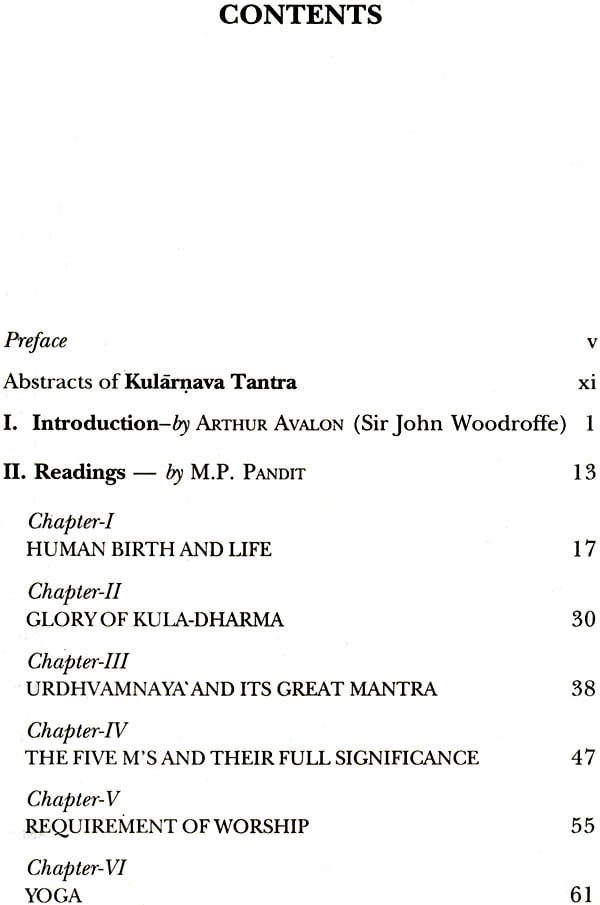
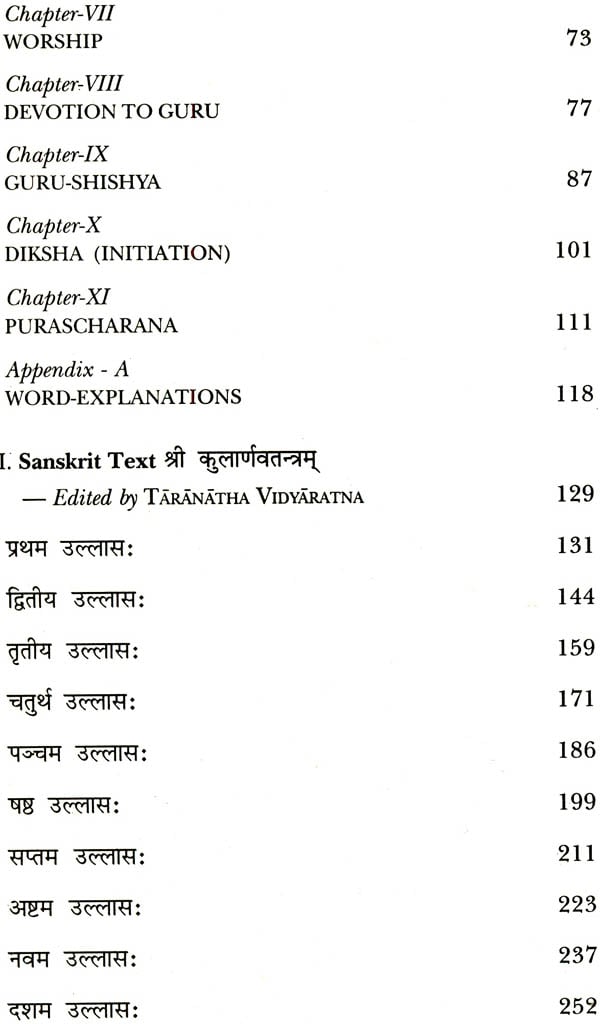
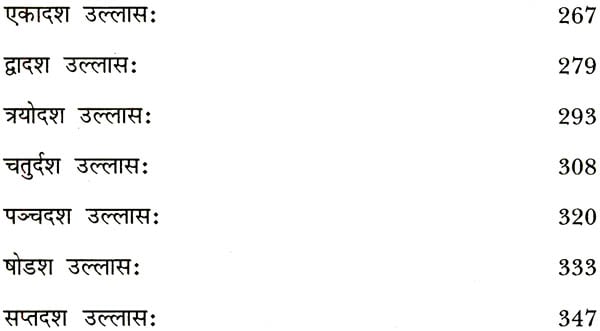



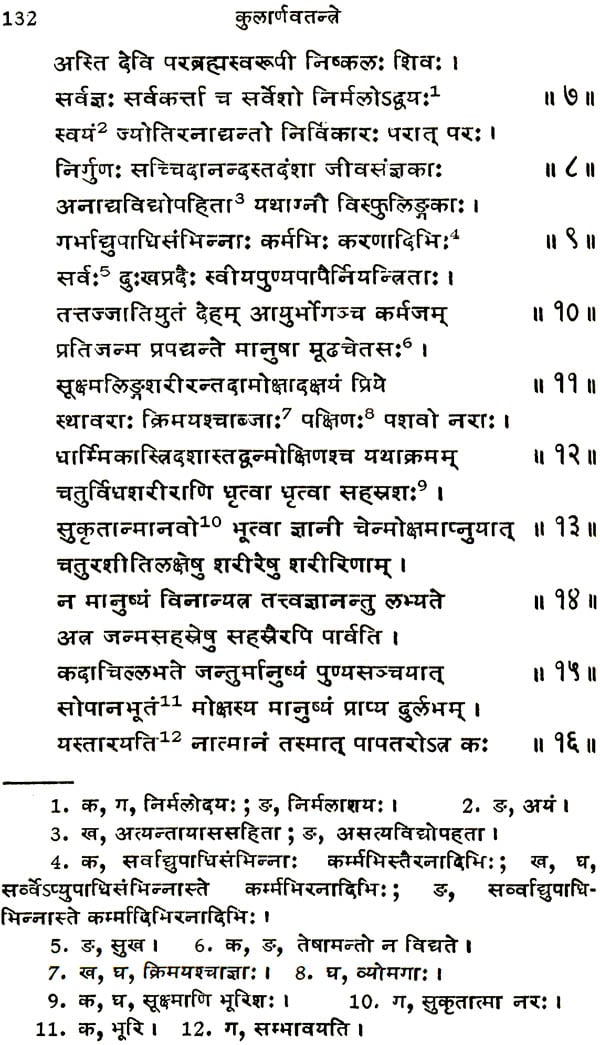
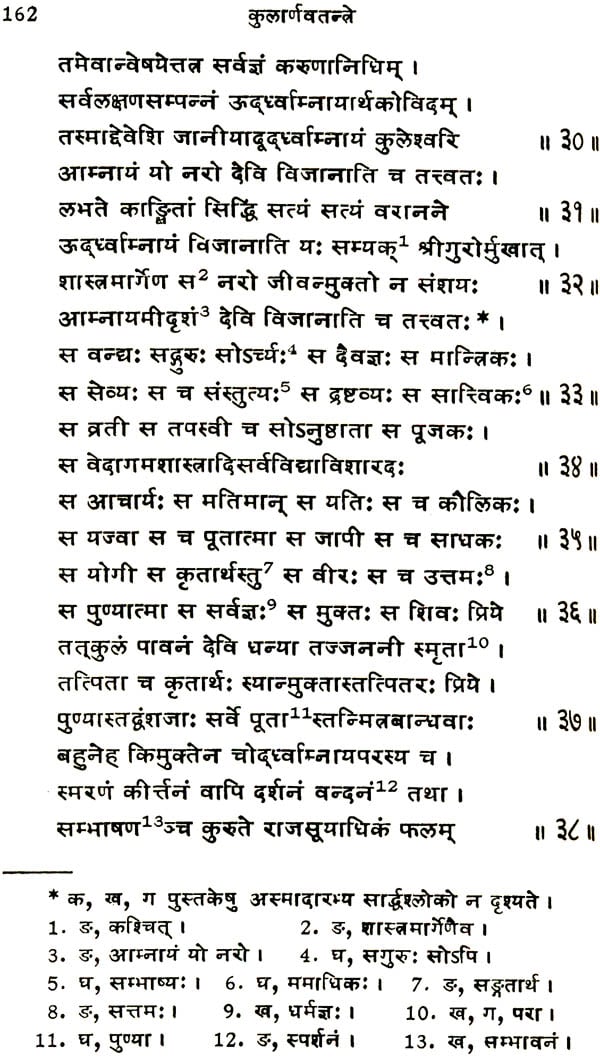
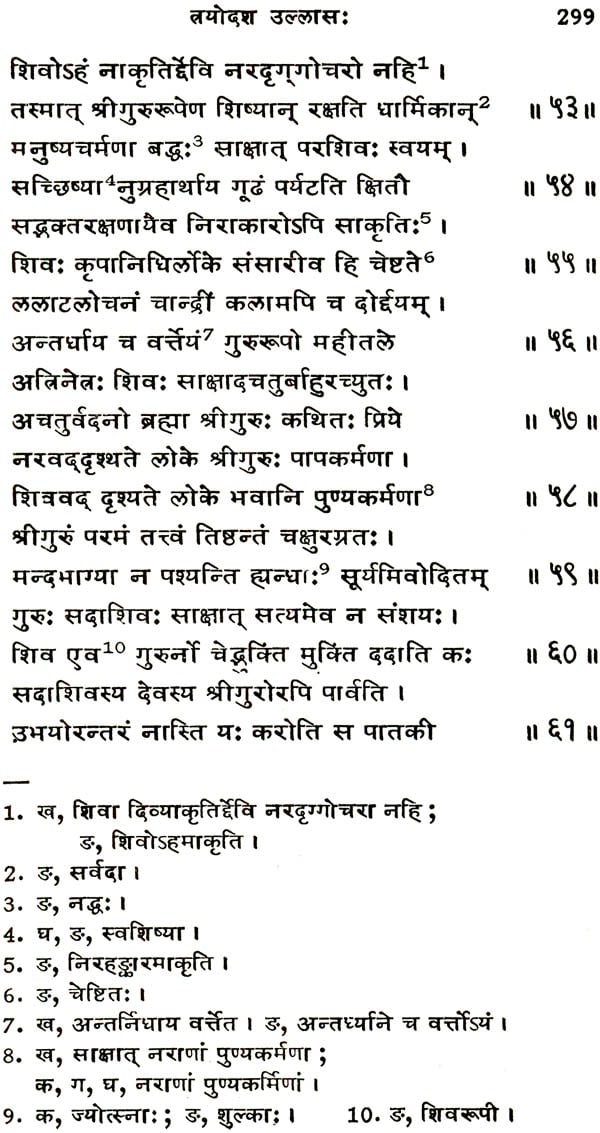
Delivery and Shipping Policy
- INTERNATIONAL SHIPPING
- Rs.1000-1100/kg
- ESTD. Delivery Time: 2-3 weeks (depending on location)
- Bubble Wrapped with Extra Padding
- NATIONAL SHIPPING
- NCR: Rs. 30/half kg
- Standard: Rs. 80/half kg
- Express shipments also available on Request
- ESTD. Delivery Time: Ranging from 1-4 days up to 7 business days (Depending on your choice of Delivery)
- TRACKING
- All orders; national or international, will be provided with a Tracking ID to check the status of their respective orders
- Depending on the Shipping Service, Tracking ID may be used on their respective tracking portals
Frequently Asked Questions (FAQs)
Domestic Shipping: 3-4 Days (after shipping)
International Shipping: 1-2 weeks (based on your location)
You will receive an email once your order has been shipped or you can email us if you didn't receive tracking details (info@mlbd.co.in)
Every book that we sell is the latest edition except all the rare books
Yes, we do provide free shipping, only on domestic orders (within India) above Rs.1500











